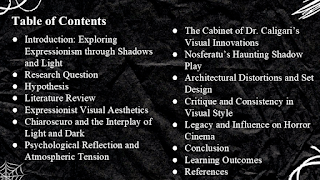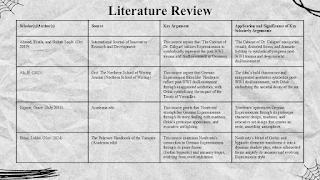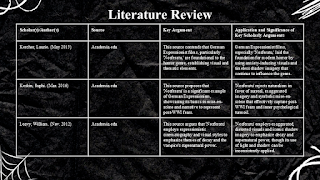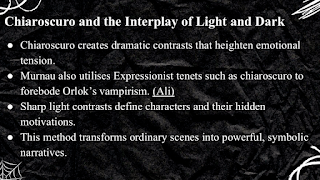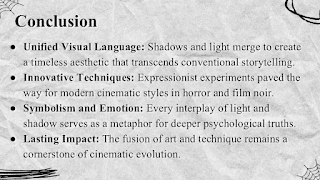Paper 110A | Shadows and Light: Exploring Expressionism in ‘The Cabinet of Dr. Caligari’ and ‘Nosferatu: A Symphony of Horror’
Paper 110A | Shadows and Light: Exploring Expressionism in ‘The Cabinet of Dr. Caligari’ and ‘Nosferatu: A Symphony of Horror’
{getToc} $title={Table of Contents} $count={false}
M.A. Sem - 2 | Presentation
Presentation Season - 2
Paper - 110A: History of English Literature – From 1900 to 2000
Submitted Date: April 1, 2025
Paper Name: History of English Literature – From 1900 to 2000
Topic: Shadows and Light: Exploring Expressionism in ‘The Cabinet of
Dr. Caligari’ and ‘Nosferatu: A Symphony of Horror’
Presentation Link:
Click here
Video Link:
Click here
Please visit this blog to explore additional presentations from this
season:
Click here
Shadows and Light: Exploring Expressionism in ‘The Cabinet of
Dr. Caligari’ and ‘Nosferatu: A Symphony of Horror’
from
Rajdeep Bavaliya
Slide - 1: Title
Shadows and Light: Exploring Expressionism in ‘The Cabinet of Dr. Caligari’ and ‘Nosferatu: A Symphony of Horror’
Prepared by Rajdeep A. Bavaliya
Slide - 2: Academic Details
Presented by: Rajdeep A. Bavaliya
Roll No.: 21
Enrollment No.: 5108240006
Sem.: 2
Batch: 2024-26
E-mail: rajdeepbavaliya2@gmail.com
Slide - 2: Presentation Details
Paper Name: History of English Literature – From 1900 to 2000
Paper No.: 110A
Paper Code: 22403
Unit: 2 - Trends and Movements
Topic: Shadows and Light: Exploring Expressionism in ‘The Cabinet of Dr. Caligari’ and ‘Nosferatu: A Symphony of Horror’
Submitted To: Smt. Sujata Binoy Gardi, Department of English, Maharaja Krishnakumarsinhji Bhavnagar University
Submitted Date: April 1, 2025
Slide - 3: Table of Contents
- Introduction: Exploring Expressionism through Shadows and Light
- Research Question
- Hypothesis
- Literature Review
- Expressionist Visual Aesthetics
- Chiaroscuro and the Interplay of Light and Dark
- Psychological Reflection and Atmospheric Tension
- The Cabinet of Dr. Caligari’s Visual Innovations
- Nosferatu’s Haunting Shadow Play
- Architectural Distortions and Set Design
- Critique and Consistency in Visual Style
- Legacy and Influence on Horror Cinema
- Conclusion
- Learning Outcomes
- References
Slide - 4: Introduction: Exploring Expressionism through Shadows and Light
German Expressionist cinema distorts reality using exaggerated visuals and symbolic imagery. (Keskin)
This style emerged as a response to post-war trauma, reflecting a nation’s deep psychological scars through unconventional aesthetics.
The movement rejects naturalism in favor of surreal, emotionally charged scenes. (Keskin)
By emphasizing inner states over external reality, films evoke a world where every visual element speaks to hidden fears and hopes.
Shadows and light are not mere elements but active conveyors of meaning.
The interplay creates moods that reveal underlying tensions and drive the narrative without relying on dialogue.
Caligari and Nosferatu stand as archetypes of this innovative visual approach.
Their groundbreaking techniques set the stage for modern horror and cinematic storytelling by embedding symbolism into every frame.
Slide - 5: Research Question
How do shadows and light function to intensify thematic depth and emotional impact in these Expressionist films?
Slide - 5: Hypothesis
The deliberate interplay of shadows and light in ‘The Cabinet of Dr. Caligari’ and ‘Nosferatu: A Symphony of Horror’ heightens narrative tension and deepens the portrayal of psychological horror.
Slide - 6: Literature Review
1. Scholar(s)/Author(s):
Ahmed, Risala, and Shihab Saqib. (Oct. 2019)
Source:
International Journal of Innovative Research and Development
Key Argument:
This source argues that ‘The Cabinet of Dr. Caligari’ utilizes Expressionism to symbolically represent the post-WWI trauma and disillusionment in Germany.
Application and Significance of Key Scholarly Arguments:
‘The Cabinet of Dr. Caligari’ uses garish visuals, distorted forms, and dramatic lighting to symbolically express post-WWI trauma and deep societal disillusionment.
2. Scholar(s)/Author(s):
Ali, H. (2025)
Source:
Grit: The Northern School of Writing Journal (Northern School of Writing)
Key Argument:
This source argues that German Expressionist films like ‘Nosferatu’ reflect post-WWI disillusionment through exaggerated aesthetics, with Orlok symbolizing the impact of the Treaty of Versailles.
Application and Significance of Key Scholarly Arguments:
The film’s bold chiaroscuro and exaggerated aesthetics symbolize post-WWI disillusionment, with Orlok embodying the societal decay of the era.
3. Scholar(s)/Author(s):
Gipson, Grace. (July 2013)
Source:
Academia.edu
Key Argument:
This source posits that ‘Nosferatu’ exemplifies German Expressionism through its story dealing with madness, Orlok’s grotesque appearance, and evocative set/lighting.
Application and Significance of Key Scholarly Arguments:
‘Nosferatu’ epitomizes German Expressionism through its grotesque character design, madness, and evocative set design that creates an eerie, unsettling atmosphere.
4. Scholar(s)/Author(s):
Heiss, Lokke. (Nov. 2024)
Source:
The Palgrave Handbook of the Vampire (Academia.edu)
Key Argument:
This source examines Nosferatu’s connection to German Expressionism through its genre fusion (Gothic/hypnotic) and uncanny tropes, evolving from overt stylization.
Application and Significance of Key Scholarly Arguments:
Nosferatu’s blend of Gothic and hypnotic elements transforms it into a dynamic shadow play, where silhouetted forms amplify its uncanny and evolving Expressionist style.
Slide - 7: Literature Review
5. Scholar(s)/Author(s):
Kercher, Laurie. (May 2015)
Source:
Academia.edu
Key Argument:
This source contends that German Expressionist films, particularly ‘Nosferatu,’ are foundational to the horror genre, establishing visual and thematic elements.
Application and Significance of Key Scholarly Arguments:
German Expressionist films, especially ‘Nosferatu,’ laid the foundation for modern horror by using anxiety-inducing visuals and timeless shadow imagery that continue to influence the genre.
6. Scholar(s)/Author(s):
Keskin, Suphi. (Mar. 2016)
Source:
Academia.edu
Key Argument:
This source proposes that ‘Nosferatu’ is a significant example of German Expressionism, showcasing its basics in mise-en-scène and narrative to represent post-WWI fears.
Application and Significance of Key Scholarly Arguments:
‘Nosferatu’ rejects naturalism in favor of surreal, exaggerated imagery and symbolic mise-en-scène that effectively capture post-WWI fears and inner psychological turmoil.
7. Scholar(s)/Author(s):
Leavy, William. (Nov. 2012)
Source:
Academia.edu
Key Argument:
This source argues that ‘Nosferatu’ employs expressionistic cinematography and visual styles to emphasize themes of decay and the vampire’s supernatural power.
Application and Significance of Key Scholarly Arguments:
‘Nosferatu’ employs exaggerated, distorted visuals and iconic shadow imagery to emphasize decay and supernatural power, though its use of light and shadow can be inconsistently applied.
Slide - 8: Expressionist Visual Aesthetics
German Expressionism rejects realism in favor of abstract, distorted imagery.
This aesthetic transforms everyday reality into a surreal experience, challenging conventional perceptions with warped visuals.
The style features garish, unnatural colors, jagged lines, and sharp contrasts. (Ahmed and Saqib)
Such elements evoke heightened emotions, mirroring internal conflicts and psychological states through bold design.
Mise-en-scène is meticulously arranged to mirror the inner world of characters.
Every set, prop, and actor placement is designed to convey mood and meaning, merging visual form with narrative content.
A dynamic interplay of light and shadow transforms static scenes into moving narratives.
The deliberate contrast elevates the storytelling, allowing visual cues to hint at deeper themes and hidden dangers.
Slide - 9: Chiaroscuro and the Interplay of Light and Dark
Chiaroscuro creates dramatic contrasts that heighten emotional tension.
By juxtaposing stark light against deep shadows, the films build suspense and underline themes of duality and conflict.
Murnau also utilises Expressionist tenets such as chiaroscuro to forebode Orlok’s vampirism. (Ali)
This technique not only defines the visual style but also foreshadows the malevolence lurking behind every dark corner.
Sharp light contrasts define characters and their hidden motivations.
The interplay of illumination and obscurity offers visual clues to a character’s inner turmoil and sinister intent.
This method transforms ordinary scenes into powerful, symbolic narratives.
Light and dark become storytellers themselves, communicating emotions and conflicts without a single word.
Slide - 10: Psychological Reflection and Atmospheric Tension
Visual distortions externalize inner fears and unsettled psyches.
The skewed sets and exaggerated shadows mirror the characters’ internal conflicts and societal anxieties.
The expressionistic elements produce feelings of anxiety and confusion. (Kercher)
This deliberate visual chaos creates an atmosphere that keeps the audience on edge, mirroring the characters’ disturbed minds.
Subtle shifts in lighting intensify an ever-present sense of dread.
Variations in brightness and darkness work together to evoke a haunting mood that pervades every scene.
Shadows serve as metaphors for suppressed emotions and hidden terrors.
The careful balance between light and dark symbolizes the ongoing battle between hope and despair in human nature.
Slide - 11: The Cabinet of Dr. Caligari’s Visual Innovations
Caligari introduces distorted architecture and surreal set design.
Its twisted, unconventional environments dismantle normal perspectives, creating a world that is as unsettling as it is imaginative.
There are no right angles in Wiene’s Caligari. Everything in Caligari’s universe is bent, twisted, and distorted. (Leavy)
This radical design choice defies geometric norms, reinforcing the film’s departure from reality and heightening its eerie impact.
Even the actors appear to have been painted into the image. (Leavy)
The visual treatment blurs the lines between performance and art, enhancing the theatrical, otherworldly feel of the film.
Painted shadows and deliberate contrasts form a core part of its mise-en-scène.
Every element is carefully crafted to evoke a sense of disorientation and to mirror the fractured psyche of its characters.
Slide - 12: Nosferatu’s Haunting Shadow Play
Nosferatu employs shadows as active narrative devices.
Shadows in the film are not just absence of light; they convey presence, menace, and the supernatural in an almost tangible way.
Murnau’s vampire is represented in numerous shots by his enormous shadow falling over his victims. (Leavy)
This striking visual emphasizes Orlok’s predatory nature and reinforces the terror he embodies throughout the film.
The iconic image of the vampire’s shadow on the staircase cements the film’s visual legacy. (Leavy)
Such memorable scenes highlight the power of visual symbolism in evoking horror and setting a benchmark for future films.
Strategic shadow play creates an omnipresent, haunting ambiance that lingers.
The pervasive darkness amplifies the narrative’s eerie tone, making the unseen as threatening as what is directly shown.
In dramatic moments, Nosferatu becomes a shadow play where only silhouettes hint at hidden threats. (Heiss)
This technique leverages off-screen movement and fragmented visuals to suggest a malevolent force that intensifies the film’s suspense.
Slide - 13: Architectural Distortions and Set Design
Expressionist architecture enhances the overall sense of disquiet and otherworldliness.
Unnatural, exaggerated building designs create an unsettling backdrop that mirrors the psychological disturbance of the era.
As one could see many of the buildings at the top had very sharp and pointy tops almost resembling that of a witch or sorcerer’s hat. (Gipson)
This vivid imagery underlines the film’s deliberate use of architecture to evoke a sinister and magical atmosphere.
Deliberate set design orchestrates the interplay between light and shadow seamlessly.
Every structural element is chosen to enhance the visual narrative, integrating the environment as a storyteller in its own right.
Mise-en-scène unifies actors, props, and architecture into a cohesive symbolic framework.
The carefully crafted settings deepen the narrative by visually representing the internal states and conflicts of the characters.
Slide - 14: Critique and Consistency in Visual Style
Both films showcase innovative visuals yet invite critical scrutiny over technique consistency.
While their groundbreaking styles captivate, some choices raise questions about balance between artistic vision and clarity.
However, Murnau is inconsistent in his efforts with this [use of light and shadow], as a truly consistent application of the style would have rendered much of the film underexposed and difficult to view. (Leavy)
This critique highlights the tension between aesthetic innovation and practical filmmaking, prompting debate on technical execution.
Such critiques provoke discussions on the limits and evolution of Expressionist aesthetics.
They remind us that even revolutionary techniques are subject to interpretation and technical constraints that influence overall impact.
The dialogue between visionary art and filmmaking practice remains essential in understanding these classics.
This ongoing conversation enriches our appreciation for the delicate balance required to evoke emotion and narrative through visuals.
Slide - 15: Legacy and Influence on Horror Cinema
The innovative interplay of shadows and light redefined visual storytelling in cinema.
The techniques pioneered in these films set a new standard, influencing countless works in the horror genre and beyond.
Shadows of Murnau and Wiene can be seen and felt in nearly all horror films made since 1922. (Kercher)
Their groundbreaking methods continue to inspire modern directors, embedding Expressionist aesthetics into the fabric of contemporary film.
The fusion of atmospheric lighting with distorted visuals laid the foundation for film noir and psychological horror.
These visual legacies demonstrate how early experiments in shadow play persist as key narrative tools in modern cinematic language.
Their artistic innovations bridge early cinematic experimentation with today’s visual storytelling techniques.
This enduring influence reinforces the importance of Expressionism as both a historical movement and a living, evolving art form.
Slide - 16: Conclusion
Unified Visual Language: Shadows and light merge to create a timeless aesthetic that transcends conventional storytelling.
The interplay of chiaroscuro and distorted visuals encapsulates the core of Expressionist cinema, merging emotion and narrative seamlessly.
Innovative Techniques: Expressionist experiments paved the way for modern cinematic styles in horror and film noir.
The groundbreaking methods used in Caligari and Nosferatu continue to inspire contemporary filmmakers, establishing a lasting legacy in visual storytelling.
Symbolism and Emotion: Every interplay of light and shadow serves as a metaphor for deeper psychological truths.
These visual cues not only intensify the atmosphere but also reveal the characters’ inner conflicts and societal anxieties, enriching the narrative.
Lasting Impact: The fusion of art and technique remains a cornerstone of cinematic evolution.
The dynamic balance between aesthetic innovation and narrative clarity underscores the enduring influence of Expressionist cinema on the broader film landscape.
Slide - 17: Learning Outcomes
My view of visual storytelling has transformed, revealing how shadows and light embody deep emotion.
The exploration of these films has expanded my understanding of how visual elements can powerfully express internal conflicts and mood.
I now appreciate the innovative role of Expressionist techniques in shaping cinematic language.
Recognizing the symbolic use of light and shadow has deepened my insight into how filmmakers convey complex psychological narratives.
Exploring these classics has reshaped my understanding of historical and cultural contexts.
I have gained a richer perspective on how post-war sentiments and artistic rebellion influenced groundbreaking visual experimentation.
This study has inspired a renewed passion for analyzing the craft behind visual storytelling.
My personal insights now embrace the power of cinema as an art form that communicates both overt narratives and subtle emotional truths.
Slide - 18: References
Ahmed, Risala, and Shihab Saqib. “Trauma of the First World War Through Expressionism: A Study of the Cabinet of Dr. Caligari.” International Journal of Innovative Research and Development, vol. 8, no. 10, Oct. 2019, https://doi.org/10.24940/ijird/2019/v8/i10/oct19071.
Ali, H. “Modernist Concerns in German Expressionist Cinema.” Grit: The Northern School of Writing Journal, vol. 1, no. 4, 2025. Northern School of Writing, openjournals.salford.ac.uk/grit/article/id/290.
The Cabinet of Dr. Caligari. Directed by Robert Wiene, Decla-Film, 1920.
Gipson, Grace. “How Is the Film Nosferatu an Example of German Expressionism?” Academia.edu, July 2013, www.academia.edu/3930902/How_is_the_film_Nosferatu_an_example_of_German_Expressionism.
Heiss, Lokke. “Nosferatu and Its Relationship to German Expressionist Film.” The Palgrave Handbook of the Vampire, Nov. 2024. Academia.edu, www.academia.edu/124838122/Nosferatu_and_Its_Relationship_to_German_Expressionist_Film.
Slide - 19: References
Kercher, Laurie. “The Origins of Horror: The Continuing Influence of German Expressionism on the Horror Film Genre.” Academia.edu, May 2015, www.academia.edu/40789722/The_Origins_of_Horror_The_Continuing_Influence_of_German_Expressionism_on_the_Horror_Film_Genre.
Keskin, Suphi. “An Overview to German Expressionism Through Friedrich Murnau’s Nosferatu.” Academia.edu, Mar. 2016, www.academia.edu/22669378/An_Overview_to_German_Expressionism_through_Friedrich_Murnaus_Nosferatu.
Leavy, William. “NOSFERATU: Murnau’s Use of Expressionism in His Film.” Academia.edu, Nov. 2012, www.academia.edu/2205991/NOSFERATU_Murnaus_Use_of_Expressionism_in_his_Film.
Nosferatu: A Symphony of Horror. Directed by F. W. Murnau, Prana Film, 1922.
Oza, Preeti. “Aesthetics of Horror in Cinema (Celebrating 100 years of The Cabinet of Dr. Caligari: World’s First Horror Film).” ResearchGate, Dec. 2021, www.researchgate.net/publication/356843619_Aesthetics_of_Horror_in_Cinema_Celebrating_100_years_of_The_Cabinet_of_Dr_Caligari_World’s_First_Horror_Film.
Schultz, H. Stefan. “German Expressionism: 1905-1925.” Chicago Review, vol. 13, no. 1, 1956, pp. 8–24. JSTOR, doi.org/10.2307/25293491.
PowerPoint template source: Canva
Slide - 20: Thank you! Any questions?
Questions:
Q.-1.|How might the integration of sound and music alter the perception of shadows and light in silent Expressionist films?
Answer:
Sound and music add extra layers to the visual experience. They change how the audience feels about dark shadows and bright lights. The audio can make the mood more intense and emotional. It highlights key moments and deepens the storytelling.
Q.-2.|In what ways could modern digital technologies reinterpret the traditional Expressionist techniques of chiaroscuro and distorted visuals?
Answer:
Modern digital tools use computer graphics to sharpen light and dark contrasts. They can create precise distortions that enhance the Expressionist style. These technologies offer more creative control and innovative effects. They blend traditional methods with new visual techniques.
Description:
Dive into the haunting worlds of German Expressionism as we unravel how shadows and light elevate ‘The Cabinet of Dr. Caligari’ and ‘Nosferatu: A Symphony of Horror’ into timeless masterpieces. Discover the psychological power of chiaroscuro, distorted sets, and evocative silhouettes that shaped modern horror. Whether you’re a film buff or a budding cinephile, this journey through post‑WWI trauma and surreal visuals will leave you seeing movies in a whole new light. Hit play, share your favorite shock‑and‑awe moment in the comments, and don’t forget to subscribe for more deep‑dives into cinema’s most influential movements!
Hashtags:
#GermanExpressionism #SilentHorror #Caligari #Nosferatu #Chiaroscuro #VisualStorytelling #FilmHistory #HorrorCinema #CinematicArt #ExpressionistAesthetics
Keyword Tags:
Expressionism, The Cabinet of Dr. Caligari, Nosferatu, silent film horror, film noir origins, German Expressionist cinema, chiaroscuro techniques, cinematic shadows, psychological horror, visual aesthetics




